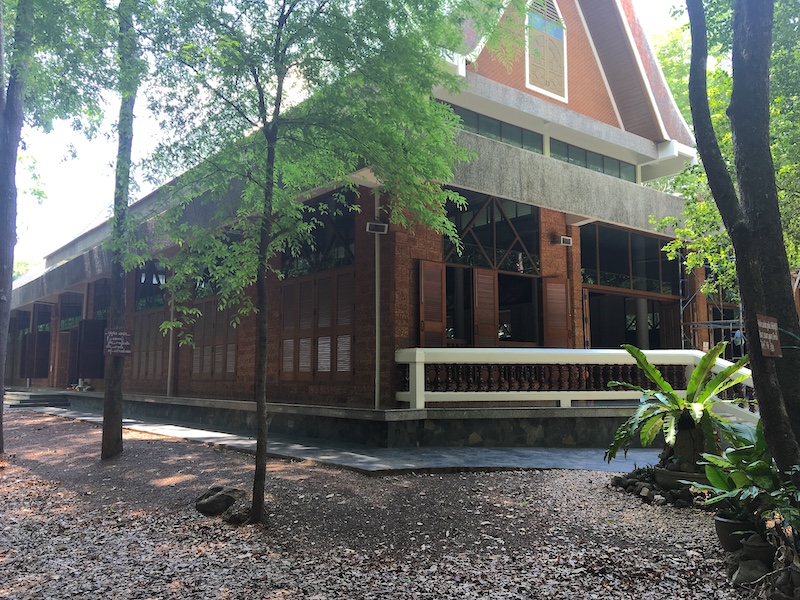
Other Meditation Retreats listed here >
A self-guided retreat is possible at Wat Nong Pah Pong for English speakers, but they will probably suggest you go to Wat Pah Nanachat instead for ease of communicating entirely in English. Both temples are located close to each other and are easily found.
The first sections here give some history and background about this famous temple and its founder. The information about a private self-guided meditation retreat follows.
Wat Nong Pah Pong Temple, Warin Chamrap, Ubon Ratchathani
Wat Nong Pah Pong, located in Warin Chamrap, Ubon Ratchathani, Thailand, is one of the most famous forest monasteries in the country and is the birthplace of the Thai Forest Tradition in the modern era.
This temple holds great significance as it was founded by the highly revered Ajahn Chah Subhatto, one of the most influential figures in Theravada Buddhism, and it continues to be a focal point for meditation and monastic life.
Wat Nong Pah Pong is a pivotal institution in the Thai Forest Tradition of Theravada Buddhism, renowned for its strict adherence to monastic discipline and emphasis on mindfulness and insight meditation. Founded by the legendary Ajahn Chah in 1954, it remains a key center for Buddhist practice and training, attracting monks, nuns, and lay practitioners from all over the world.
Under the current guidance of Ajahn Liem, the temple continues to preserve and propagate the teachings of Ajahn Chah, fostering a deep commitment to simplicity, meditation, and the cultivation of wisdom.
History and Establishment
Wat Nong Pah Pong was established in 1954 by Ajahn Chah, who sought to revive the traditional Thai Forest Monastic Tradition, a strict and disciplined form of Theravada Buddhism that emphasizes meditation, mindfulness, and the Vinaya (monastic code). Before founding Wat Nong Pah Pong, Ajahn Chah had spent years wandering and practicing asceticism (dhutanga) in the forests of Thailand and Laos, searching for enlightenment.
Ajahn Chah became renowned for his wisdom, humility, and ability to teach profound Buddhist truths in simple, direct language. His influence attracted many monks and lay practitioners, both Thai and foreign, to Wat Nong Pah Pong. The temple became a training center for serious meditators and monks, and it has since grown into an important institution within the Thai Buddhist Sangha.
Founder – Ajahn Chah
Ajahn Chah (1918–1992) was a Thai monk who is considered one of the most important figures in Thai Theravada Buddhism. His approach emphasized living the Vinaya (monastic code) strictly and practicing meditation in a natural setting, often in the forest. His teachings were centered on simplicity, mindfulness, and direct insight into the nature of the mind.
Ajahn Chah’s teachings spread globally through the Ajahn Chah lineage, and many of his Western disciples, including Ajahn Sumedho and Ajahn Brahm, went on to establish monasteries around the world, including in the UK, USA, Australia, and Europe. These monasteries continue the tradition of forest meditation that Ajahn Chah emphasized.
Monastic Community
Wat Nong Pah Pong is home to a large and thriving community of monks and mae chee (nuns), as it serves as a central monastery for the Thai Forest Tradition. The exact number of residents may vary, but there are typically hundreds of monks living and training at the monastery at any given time, as well as a significant number of mae chee (female practitioners who take eight or ten precepts, often compared to nuns).
- The temple serves as the headquarters of over 300 branch monasteries in Thailand and around the world, making it a vital center for those following the forest tradition. These branch monasteries are scattered throughout the world, especially in Western countries.
Daily Life and Practice
Life at Wat Nong Pah Pong is centered around meditation, chanting, and monastic discipline. The monks and nuns follow a strict routine, which includes:
- Alms rounds in the morning, where monks walk barefoot to receive food from the lay community.
- Morning and evening chanting and meditation.
- Meditation practice, both sitting and walking, throughout the day.
- Dhamma talks given by senior monks, often focused on mindfulness, insight, and the practical application of Buddhist teachings.
The monastic community adheres closely to the Vinaya, the code of conduct for monks, and leads a simple, minimalist life, focusing on spiritual development and the abandonment of worldly attachments.
Teachings and Influence
Ajahn Chah’s teachings at Wat Nong Pah Pong are centered on mindfulness (sati), simplicity, and insight into the nature of suffering. His style was informal yet profound, emphasizing practical wisdom that could be applied to everyday life, not just theoretical knowledge.
Some key aspects of Ajahn Chah’s teachings include:
- Mindfulness in all activities. Ajahn Chah encouraged monks and laypeople to cultivate mindfulness in every moment, whether during formal meditation or everyday tasks.
- Letting go. He taught that true freedom and peace come from letting go of attachment to desires, thoughts, and even concepts of self.
- Direct experience over intellectual knowledge. Ajahn Chah emphasized the importance of direct meditative experience and discouraged getting caught up in intellectual debates about Buddhist philosophy.
- Vinaya and discipline. Strict adherence to the monastic code was seen as essential for developing mindfulness and wisdom.
Global Reach
Through Ajahn Chah’s disciples, the teachings and practice of Wat Nong Pah Pong have spread around the world. There are over 300 branch monasteries, with many located outside Thailand. Notable international monasteries include:
- Amaravati and Cittaviveka in the UK, founded by Ajahn Sumedho.
- Bodhinyana Monastery in Australia, founded by Ajahn Brahm.
- Abhayagiri Monastery in California, USA.
These monasteries follow the same principles of strict monastic discipline, mindfulness, and meditation that Ajahn Chah taught at Wat Nong Pah Pong.
Meaning of Name
Wat Nong Pah Pong means ‘forest monastery of marsh and pong’ (pong is a type of high grass).
Address
Non Peung, Ban Gor, Ampur Warin, Ubon Ratchathani 34190
Directions to Wat Nong Pah Pong
Located 12 km southeast of Ubon Ratchathani or 10 km southeast of Warin. See Wat Pah Nana directions above for transport to Ubon. From Ubon, you can take a pink bus to its terminus in Ban Gor, then walk or take a tuk-tuk 2 km west to the monastery.
You can walk to Wat Nong Pah Pong from Wat Pah Nana in 1.5 hours on a series of dirt roads, footpaths, and roads. Just ask to see the map at Wat Pah Nanachat. Be aware that dogs are a problem for foreigners in Thailand. You probably should take a songtaew or motorbike taxi.
Current Abbot
The current abbot of Wat Nong Pah Pong is Venerable Ajahn Liem Thitadhammo. Ajahn Liem was a close disciple of Ajahn Chah and has been leading the monastery since Ajahn Chah became ill and passed away. Ajahn Liem is highly respected for continuing Ajahn Chah’s legacy, maintaining the strict monastic discipline, and promoting meditation practice among the monks and laypeople.
Meditation System
Similar to Wat Pah Nanachat. Anapanasati. Mindfulness of breathing.
Teaching Method
Similar to Wat Pah Nanachat, except that women have very little contact with monks. You can practice as you like, as long as it doesn’t interfere with others practicing at the temple.
Teachers
Ajahn Liam, abbot (Thai; age 50)
Language
Instruction is given in Thai; the teacher doesn’t speak English. Sometimes western or Thai monks can translate.
Description
Forest and open areas total 350 rai (140 acres). Originally this was a cremation site thought to be inhabited by ghosts. Much construction work has taken place in recent years. Arriving from the east you’ll first see a 3-story museum.
Exhibits inside include a life-like statue of Ajahn Chah, his robes and other memorabilia, archaeological finds, Buddhist art, and area crafts; bas-reliefs illustrate important events of Ajahn Chah’s life, including his visits to England; skeletons on display can be used as meditation objects.
Continuing into the monastery, you’ll arrive at a new sala, an ornate concrete bell tower (monks cast the bell), Ajahn Chah’s old kuti (monk hut) where he used to sit downstairs in a chair to meet with visitors, and a bot (main building) of modern architecture. A circular mound to the north is used as a meditation area; a chedi on top contains Ajahn Chah’s ashes.
This is one of my (Vern’s) favorite temples in Thailand for meditation or just visiting to enjoy the peace of the space. This is a quiet forest temple that has a special place in the hearts of Thais across the country and the world.
My wife’s aunt visits here many times during the month to help with feeding the monks and the community.
Size
- monks and novices: 45-70
- nuns: 45-50
- laypeople: Often a few laymen preparing for ordination. Lay disciples frequently visit for short periods.
Daily Routine
Similar to Wat Pah Nanachat. This is also a good place to combine one’s own practice with group activities in a monastic environment.
Meals
Adequate northeastern fare with sticky rice; one meal a day and an afternoon drink.
Accommodations
Monks, novices, and laymen stay in well-separated kutis; most have no water or electricity. Laywomen stay with nuns in a separate area of the monastery; laywomen must speak Thai. Women will find better conditions at Wat Pah Nanachat. Most bathing is done in shower blocks; toilets are Asian- and Western-style.
Write in Advance?
Not necessary. Show up in the morning and find a monk who speaks English if you don’t speak Thai. Ask them if you can stay and meditate as a slef-guided visit for a while. They will likely have you take part in group activities, but there will be plenty of meditation time on your own.
Ordination
Possible if one speaks fluent Thai. Most non-Thais find Wat Pah Nana more suitable for initial training. Women interested in ordaining as a nun should first contact Wat Pah Nanachat.
Other Information
One should speak Thai or be willing to learn. Long-term laymen shave their heads and eyebrows and wear white. Much of the western Theravadan Sangha originated here with the encouragement and support of Ajahn Chah.
In Thailand, Ajahn Chah earned fame by his skill at training monks in high standards of Dhamma-Vinaya. He was one of the most influential monks of Thai Buddhism. Born in nearby Ban Gor in 1918, Ajahn Chah took robes as a novice at age 13.
He was ordained as a bhikkhu (novice monk) when he was 21. In 1946, following his 8th Rains Retreat, he set out as a Phra Tudong, wandering the forests and practicing meditation in lonely places.
The teachings of Ajahn Mun and Ajahn Ginaree influenced him during this period. In 1954, Ajahn Chah accepted an invitation by his mother and villagers to return to Ban Gor to establish a new monastery — Wat Nong Pah Pong.
After many years of teaching, his health began to deteriorate, resulting in an operation to relieve cranial fluid pressure in Nov. 1981. Unfortunately, his condition worsened in mid-1982. By the end of the year, Ajahn Chah had become bedridden and unable to teach.
His monks continued to lovingly care for him. Ajahn Chah died here on January 16, 1992, at age 75. His life and teachings inspired a great many people around the world. At his funeral, which took place exactly one year later, the king and thousands of monks, nuns, and laypeople gathered to pay their respects.
Join us in Krabi, Thailand – Deep Jhana Meditation Retreat
We offer Meditation Coaching at very affordable rates of just 1,000 Thai baht per hour ($30 USD). >
[Top image of main Sala at Wat Nong Pah Pong. © Vern Lovic]
